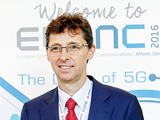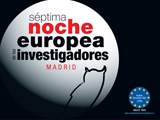IMDEA Networks

5G will transform the way we perceive and relate to the world around us
21 September 2016

Interview with Arturo Azcorra, tenured professor in the Telematics Engineering Department at Universidad Carlos III de Madrid, Spain in the context of the European Researchers’ Night in Madrid 2016.
With a doctorate in Telecommunications, Arturo Azcorra is a tenured professor in the Telematics Engineering Department at Universidad Carlos III de Madrid (UC3M) and the director of the IMDEA Networks Institute. He is the author of over one hundred papers published in journals and books, and presented at international scientific congresses; in addition, he has participated in some thirty competitive research projects funded by the European Union. Currently, he is coordinating the European 5G-Crosshaul project, which is part of the Horizon 2020 framework project for research and innovation; Professor Azcorra hopes that European Researchers Night 2016 will help to spread news about this project to the public.
What will happen during this UC3M activity?
This is an informative show that combines, dance, music, theater and audiovisuals to explain how 5G technology is going to influence our lives in the coming years. The play focuses on the story of a very unusual couple at two parallel moments: in 2016, when they fall in love; and in 2016, when they are just about to have a child. That is, we see them in the present day, when 5G technology is being developed, and we see them in the future, when it this technology is expected to be integrated into all different types of devices.
What type of public is this aimed at?
The show is conceived so that both children and adults can enjoy it and understand some of the concepts related to fifth generation mobile technology and the revolution it can bring to our lives. With this program, we mean to make the UC3M Auditorium a referent as far as the interaction between scientific advances and society, using this educational show.
How will 5G affect our lives?
The future 5G networks will transform the way we perceive and relate to the world around us. The combination of advances in 5G networks will transform our current reality into a “connected reality”, where objects and people are all connected with each other. The 5G networks will allow over 6 billion people to be connected, which means every inhabitant on the planet, as well as connecting around one thousand objects for each person. In this way, we will be permanently connected to our doctors, our friends, our co-workers, clients/suppliers, security services… but we will also be connected to our cars, our refrigerators, our favorite bakery, our leisure-time places, the subway, airport, home and, basically, everything that is of any importance to us. Moreover, those objects will also be interconnected to each other, so pallet will be able to ‘complain’ to its company of origin that its delivery route is wrong, and our water heater can download new control software that will make it more efficient.
What will be the volume of data moving through the network?
The number of devices connected will be accompanied by a three-fold increase in the network’s capacity. These 5G networks will, therefore, be able to transport a volume of mobile data that is one thousand times greater than the 4G networks that are currently being used. This massive communication capacity will enable every person or object to almost instantly access, send or exchange whatever sensations they want. The network is designed so that all of the multimode interfaces can be integrated: augmented reality devices, brain wave interfaces or the implantation of interface biochips will allow 5G network users to interact with each other and with other connected objects in a completely natural manner, without noticing any external devices, as if everything were an extension of their five senses. This stereoscopic exchange of images, smells, tactile information or brain waves can take place no matter where we are. This is because, unlike the 4G systems, the 5G networks are designed to have universal geographic coverage, with the added advantage of greater uniformity of service with regard to the relative position of the base station and the edge of the cell.
How will the energy consumption involved in so many connections be handled?
Actually, another key element in the 5G networks is the reduction in energy consumption. If we increased the network’s capacity by one thousand using current technology, it would be impossible to provide the high level of energy that it would consume. Therefore, energy efficiency is another one of the main criteria for designing the 5G networks. So, technologies with an energy consumption of only 10 percent compared to what is being used at present are being developed in order to minimize the environmental impact of 5G.
When will we all be using the 5G networks?
In 2018 pre-standard technologies known as 4.5G will begin to be launched, mainly in Europe and Asia. For the winter and summer Olympic Games, the plan if for ATOS and Ericsson demonstrate equipment and advanced entertainment applications about 5G technologies, and SAMUR (Madrid’s Municipal Emergency and Rescue Service) is already developing advanced emergency applications in order to be prepared for the move to 5G. 5G products and services are set to be launched starting in 2020, with penetration and coverage expected to expand rapidly.
What are the main challenges presented when introducing 5G networks?
The great research effort that is needed to overcome the important technological challenges that are involved and the enormous investment required to introduce them. However, due to the enormous socioeconomic benefits that it will lead to, all of the necessary human and economic resources are already in motion. 5G will lead to a great race among the most advanced regions in the world (The United States, Europe, China, Japan) to position their science and their companies as leaders in this attractive market, and to capitalize on the great social rewards that it will bring with it. The 5G networks will take us to a world where distance doesn’t exist, and where our existence and perception will merge with those of our fellow beings and with that of the objects that surround us.
How would you rate Spain’s situation as far as R+D+i in this area?
 Spain is in an excellent position in terms of R+D+i in 5G technologies. We occupy a leading position in the PPP of 5G, which is the European Commission’s most ambitious initiative in advanced telecommunications research. With a public and private budget of 7 billion Euros and a 7-year program of activities, the PPP constitutes the backbone of European R+D in 5G. In addition, European Technology Platform Networld 2020, made up of over 1,100 universities and public and private research centers throughout Europe, complements the research work being done by the 5GPPP. In both cases, the Spanish institutions are very much present at an important level.
Spain is in an excellent position in terms of R+D+i in 5G technologies. We occupy a leading position in the PPP of 5G, which is the European Commission’s most ambitious initiative in advanced telecommunications research. With a public and private budget of 7 billion Euros and a 7-year program of activities, the PPP constitutes the backbone of European R+D in 5G. In addition, European Technology Platform Networld 2020, made up of over 1,100 universities and public and private research centers throughout Europe, complements the research work being done by the 5GPPP. In both cases, the Spanish institutions are very much present at an important level.
In Spain we also have the 5TONIC laboratory, one of the most important pan-European testbeds, founded by Telefónica and IMDEA Networks, and in which Ericsson, INTEL, Commscope and UC3M are also working. Moreover, SETSI, la Consejería de Educación de la Comunidad de Madrid (Autonomous Community of Madrid Education Council) and AMETIC have signed an agreement with the members of 5TONIC, to offer committed public support to the development of 5G technologies, products and services in our country. The Secretaría de Estado de Investigación (Secretary of State for Research), the CDTI, and RedIRIS are offering strong support to 5TONIC and 5G technologies as well, using their various resources. Finally, one of the key projects for 5G technology, the 5G-Crosshaul project, is being headed up by UC3M, which also has an important role in other European 5G projects, such as the 5G Exchange, the 5G NORMA and Flex5Gware.
Where did your scientific vocation come from? When and why did you decide that you wanted to be a scientist?
I had a great scientific vocation. From the time I was very small, I loved learning how nature and machines worked and I read everything I could about the many subjects that I was interested in. When I finished my degree, I stayed in school working on research projects towards my doctorate and, later, I continued my career as a scientist, spending time abroad in institutions like MIT (Massachusetts Institute of Technology), the University of California at Berkeley and the international research institute IMDEA Networks.
What do you think of the European Researchers Night initiative?
I think it is very important to make science accessible to the public and to foment scientific vocations in our country. In the most developed countries, it is very clear to the general public that science implies well-being, quality jobs, better health and a cleaner environment. It is also clear to them that a science degree is highly recognized, socially and economically, and that it’s also very gratifying from a personal point of view. In our country, it is not seen this way yet and we have to work to make it so that science is seen the same way here as it is in the most developed countries.
Why did you decide to jump in and participate in the Night?
Getting scientific information out to society is a tremendously important task. Whenever I have the chance to take part in an activity that does that, I am happy to do it. I have given talks in high schools to motivate students to pursue science degrees; I’ve participated in informative radio programs; we take part in Madrid Science Week (Semana de la Ciencia de Madrid), and in the old “Madrid for Science” Fair, (Feria “Madrid por la Ciencia”); and I also participated in last year’s European Researchers Night, in the activity organized by the IMDEA Institutes.
This event is celebrated simultaneously in over 250 European cities. Do you think that these pan-European initiatives can influence the citizens’ perception of researchers?
In this difficult moment for Europe, where extremism, populism and xenophobia are flourishing, I think that we must read any book about recent history to know exactly where those things will lead us. The European Union has given Europe its longest period of peace and prosperity, and the response to the current problems must be more union and not more division, more solidarity and not more individualism, more responsibility and not more demagoguery. I think that pan-European research initiatives, such as the Framework Program, mobility initiatives, like the Erasmus Program, and also the Researchers Night do a great deal to strengthen European unity and the transnational vision of union and common good that we so need right now.



Recent Comments